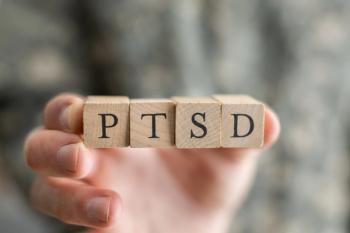
- Psychiatric Times Vol 35, Issue 12
- Volume 35
- Issue 12
Solving the Mystery of Military Mental Health: A Call to Action
The iconic scene when George C. Scott slaps the soldier with PTSD in Patton and calls him a “yellow-bellied coward” mirrors the historic and continued ambivalence of the military toward the psychological wounds of war.
In the wake of the recent Veterans’ Day observances (November 11, 2018), I had a strangely disquieting feeling. At first, I attributed it to binge-watching too many war movies that had been broadcast for the occasion (including All Quiet on the Western Front, Saving Private Ryan, Platoon, Patton). But there was also the fact that the holiday coincided with the 100th anniversary of the Armistice of WWI, the “Great War,” punctuated by the indignity of our POTUS being deterred by the weather from attending the ceremonies at the French cemetery where US soldiers were buried. But then, in a burst of insight, I realized what so upset me was when George C. Scott slaps the soldier with PTSD in Patton and calls him a “yellow-bellied coward.” This iconic scene resonates with the historic and continued ambivalence of the military toward the psychological wounds of war. It is the military equivalent to the stigma of mental illness that pervades our society-but on steroids.
Because of this stubborn aversion to the reality of psychic injuries in the military, active duty and veteran military personnel have been denied effective mental health care, and limited progress has been made in understanding the pathological basis of psychologic trauma and developing more effective treatments. Consequently, our active and veteran military personnel suffer and die unnecessarily.
Military trauma
More than 2 million troops have already been deployed to the wars in Iraq and Afghanistan with no end in sight. Almost a third of all service-persons in these ongoing conflicts suffer from some clinically significant mental condition, the poster child for which is PTSD, and their complications of suicide, addiction and domestic or other-directed violence.1,2 The shocking statistics indicate that our veterans are more than twice as likely to commit suicide than their peers in the civilian population.3
The reasons for the burgeoning rates of mental health problems among military personnel deployed to the Middle East-more than in any other war-are as yet undetermined. The possibilities include the asymmetric type of warfare, repeated tours of duty, lack of clearly defined mission. But then the rates had begun to rise during Vietnam when the army was conscripted and possibly beforehand and gone unnoticed. Regardless, the unique psychological dangers faced by our military personnel take their toll and make re-entry into civilian life difficult.
The mental health consequences of military trauma are often distressing, disabling and persistent unless there are timely interventions. Symptoms of PTSD include re-experiencing the traumatic event, avoidance of thoughts of the traumatic event and people, places, or other stimuli that evoke the trauma; changes in cognitions regarding the world and one’s self; hypervigilance; hyperarousal (including irritability, concentration difficulties, and disrupted sleep); and increases in disturbing thoughts and negative feelings. PTSD is commonly associated with functional impairment, substance abuse, suicidal ideation, impulsivity and violence, as well as increased utilization of medical care.
Treatments: too few, too late, and not good enough
Despite treatment with the available psychotherapies and pharmacotherapies, PTSD never fully remits in more than half of patients. Meta-analyses of psychotherapy for PTSD has found short-term improvements compared with baseline only in about 50% to 60% of patients, with the majority continuing to have substantial residual symptoms.4-7 The efficacy of medication in PTSD is also sub-optimal, with few patients experiencing a complete remission following pharmacotherapy.7 Moreover, there is a lack of psychopharmacologic advances in its treatment.
Because early symptoms of combat-related mental problems are a reliable predictor of chronicity and impaired social and occupational functioning, early treatment is most advantageous. Early intervention can increase functional capacity, rapid symptom recovery, prevention of maladaptive coping behaviors, and prevention of chronic PTSD and other psychopathology, including complicated grief.8,9 Unfortunately, while models of early intervention have been tested in non-military populations, they have rarely been implemented in military personnel.
Coming home: reconnecting and reintegrating
Research indicates that as many as 50% of veterans experience significant difficulty acclimating with a third developing mental health problems including PTSD, anxiety disorders and depression.10,11 Reconnecting with loved ones after repeated exposure to traumatic events and combat stress, coping with physical injuries sustained during combat, and renegotiating roles as civilians in the midst political, social, and economic crises can present an emotionally challenging experience for service members and their family members. If the psychopathology causing these problems goes untreated, chronicity develops that leads to significant social impairment, marital dysfunction, job instability, suicide, substance abuse, and violent behavior.
To compound the problem, there is an acute shortage of services, trained clinicians, and lack of expertise in evidence-based treatments, which limits the care of large numbers of redeployed veterans and their families. Moreover, the quality of services and the effectiveness of treatments are not optimal and limited federal funding has impeded much needed progress that could derive from psychobiological research on the effects of physical and psychological trauma on the brain.12-15 Indeed, current treatments for trauma-related mental health disorders, such as PTSD, suicidality, and traumatic brain injury, have yet to be proven effective for large populations of war veterans.16
The lack of available quality mental health care is compounded by the fact that active duty personnel and veterans are too often reluctant, indeed overtly deterred from seeking mental health care because of shame, stigma, and adverse career impact. For those who do seek help, a variety of logistical, cultural, and professional barriers may interfere with care access and delivery.17,18 To add insult to injury, family members of military personnel are not eligible for mental health care in VA settings. Ignoring the needs of these populations is both unfair, given their great sacrifices, and unwise, as family support is critically important for optimal adjustment of returning veterans.
A call to action
Given the scope of mental health problems among military personnel, better and more accessible mental health services must be developed. Evidence-based interventions are needed in multiple and diverse settings (in basic training, on the battlefield, following injury and upon and after discharge) and special efforts must be made to address and overcome the deterrents of stigma, guilt and impact to career by at least ensuring that all are informed how and encouraged to obtain services if needed. Provision of social services and establishment of resource- and resilience-building programs would facilitate treatment and reintegration into effective social and occupational roles.
It has long been known that war produces overwhelming psychological stress that can indelibly alter a person’s brain function and mental state. Despite the long history of PTSD (previously known as “Soldier’s Heart,” “Shell Shock,” “Battle Fatigue,” and “Combat Neurosis”), and the increasing number of psychological casualties, there has been limited progress in the scientific understanding and ability to treat PTSD.19,20 So why hasn’t more been done to address the psychological wounds of war and its sequelae?
It is not for the lack of ability to achieve great progress. The military has already demonstrated its capacity to make extraordinary advances in the medical care of its soldiers. Rates of severely wounded combatants went from 80% who died to 80% who survived between WW-I and the Iraq and Afghanistan wars. Whereas wounded soldiers writhed in pain and died from infection and exsanguination in WWI, medics now stabilize soldiers in-theater, airvac them to field hospitals where they undergo emergency surgery, then airlift them when able to travel to military hospitals in Germany for more sophisticated treatments. When recovered they are transported to the US and, if further treatment is needed, to Walter Reed National Military Center.21
I believe there are three reasons why the same has not been done for the psychological wounds of war. First, the idea of psychological weakness is antithetical to military culture with its ethos of strength and invulnerability. Thus, military leaders were disinclined to recognize and accept the possibility of psychic injury. As a result, many soldiers were accused of cowardice and in some cases punished, even executed, for their infirmity. Second, mental disorders are not tangible and have no visible physical signs or diagnostic tests by which they can be confirmed. Hence, they are not seen as real, and are thus minimized-you don’t get a Purple Heart for PTSD. Third, PTSD was considered a military problem and thus the responsibility of the Defense Department and Veteran’s Administration. Consequently, the NIH did not see this as within the scope of their mission and thus the best and the brightest biomedical researchers at academic medical institutions were not engaged in the research effort to address PTSD. Until recently, most funding for PTSD research was provided through the Veterans Administration and predominantly to researchers at VA hospitals.
There are two grievous flaws of logic in this scenario. One is that just because there is no physical lesion associated with PTSD, does not mean that it’s not a distressing and disabling condition. The other is that psychological trauma is not limited to the military but also occurs in the civilian population-though less commonly and dramatically. Therefore, this should be considered a medical problem of importance to the NIH and the whole biomedical research community, but that would have diverted funds from other disorders.
There is another reason why the measured response of our government to address military mental health is so tragic and reprehensible. Of the 265 disorders described in DSM-5, only two have known etiologies and can be readily studied in animal models-substance use disorders and PTSD. The biology of PTSD can be studied in the laboratory through fear conditioning paradigms and therapeutic approaches developed to alleviate the symptoms and potentially even prevent its development by “immunizing” those who regularly go into harm’s way.
A “Manhattan Project” for PTSD
What is needed is a “Manhattan Project” to elucidate the pathophysiology, develop effective treatments, and ultimately find a cure for PTSD. While this is a formidable scientific challenge, it is achievable.
The first step is for the Administration and Congress to empanel a task force of leading scientists to develop a strategic plan for research on the pathological basis of PTSD and develop treatments. Next, Congress must allocate funding to support the necessary research to be carried out under the auspices of the National Institutes of Health in partnership with the VA and Department of Defense. The NIH Director’s office would be responsible for monitoring progress and reporting to the President and the Congress. This effort would be sustained until sufficient progress has been made. The final step would entail establishing a network of medical centers in addition to the VA Hospitals to provide specialized mental health services for veterans, and mechanisms for reimbursement.
It is time for our government to right this historic wrong. Amidst the political gridlock in Washington and polarized opinions of the electorate, there is one thing on which everyone agrees, it is our respect and concern for US military personnel. Images and statistics of returning vets with lost limbs, injured brains, and traumatized psyches have seared the public consciousness and evoked an outpouring of compassion. We are light-years away from the Vietnam era vilification of the military. Let us pledge that not another Veteran’s Day shall pass without our government, biomedical research, and medical communities committing to solve the mystery of psychological trauma and remove this scourge from those who place themselves in harm’s way to defend us and our freedoms.
Disclosures:
Jeffrey Lieberman, MD, is the Lawrence E. Kolb Professor and Chairman of the Columbia University Vagelos College of Physicians and Surgeons Department of Psychiatry and Psychiatrist-in-Chief of the New York Presbyterian Hospital-Columbia University Irving Medical Center. Dr Lieberman is a member of the National Academy of Medicine and past president of the American Psychiatric Association. He is the author of Shrinks: The Untold Story of Psychiatry (Little Brown 2015).
References:
1. Hoge CW, Castro CA, Messer SC, et al. Combat duty in Iraq and Afghanistan, mental health problems, and barriers to care. N Engl J Med. 2004;351:13-22.
2. Hoge CW, Auchterlonie JL, Milliken CS. Mental health problems, use of mental health services, and attrition from military service after returning from deployment to Iraq or Afghanistan. JAMA. 2006;295:1023-1032.
3. McCarthy JF, Blow FC, Ignacio RV, et al. Suicide among patients in the Veterans Affairs health system: rural-urban differences in rates, risks, and methods. Am J Pub Health. 2012;102((Suppl 1):S111-S117.
4. Eftekhari A, Ruzek RI, Crowley JJ, et al. Effectiveness of national implementation of prolonged exposure therapy in Veterans Affairs care. JAMA Psychiatry. 2013;70:949-955.
5. Institute of Medicine. Psychosocial Interventions for Mental and Substance Use Disorders: A Framework for Establishing Evidence-Based Standards. Washington, DC: The National Academies Press; 2015.
6. Monson CM, Schnurr PP, Resick PA, et al. Cognitive processing therapy for veterans with military-related posttraumatic stress disorder. J Consult Clin Psychol. 2006;74:898-907.
7. Stein MB, Rothbaum BO. 175 years of progress in PTSD therapeutics: learning from the past. Am J Psychiatry. 2018;175:508.
8. Litz BT. Early Intervention for Trauma and Traumatic Loss. New York, NY: Guilford; 2004.
9. Neria Y, Litz BT. Bereavement by traumatic means: the complex synergy of trauma and grief. J Loss Trauma. 2004;9:73-88.
10. Dohrenwend BP, Turner JB, Turse NA, et al. The psychological risks of Vietnam for U.S. veterans: a revisit with new data and methods. Science. 2006;313:979-982.
11. Jones E, Wessely S. Shell shock to PTSD: military psychiatry from 1900 to the Gulf War. Phil AS, Wykes T, Eds. Maudsley Monographs #47. New York, NY: Psychology Press; 2005.
12. Government Accountability Office. VA Mental Health: Clearer Guidance on Access Policies and Wait-Time Data Needed. Washington, DC; 2015.
13. Government Accountability Office. Veterans Health Administration: Management Attention Is Needed to Address Systemic, Long-Standing Human Capital Challenges. Washington, DC; 2016.
14. Government Accountability Office. 2017. VA Health Care: Improvements Needed in Data and Monitoring of Clinical Productivity and Efficiency. Washington, DC: Government Accountability Office.
15. Garcia HA, McGeary CA, McGeary DD, et al. 2014. Burnout in Veterans Health Administration mental health providers in posttraumatic stress clinics. Psychol Serv. 11:50-59.
16. Rosen CS, Matthieu MM, Wiltsey Stirman S, et al. A review of studies on the system-wide implementation of evidence-based psychotherapies for posttraumatic stress disorder in the Veterans Health Administration. Admin Policy Mental Health Mental Health Serv Res. 2016;43:957-977.
17. Maguen S, Litz BT. Predictors of barriers to mental health treatment for Kosovo and Bosnia peacekeepers: a preliminary report. Mil Med. 2006;171:454-458.
18. Department of Veterans Affairs. Healthcare Inspection: Post-Traumatic Stress Disorder Counseling Services at Vet Centers. Washington, DC: VA Office of Inspector General; 2011.
19. Menninger KA. Nomenclature of psychiatric disorders and reactions, 1943. J Clin Psychol. 2000;56:925-934.
20. Shephard B. A War of Nerves: Soldiers and Psychiatrists in the Twentieth Century. Cambridge, MA: Harvard University Press; 2001.
21. Ling GS, Rhee P, Ecklund JM. Surgical innovations arising from Iraq and Afghanistan wars. Annu Rev Med. 2010;61:457-468.
Articles in this issue
almost 7 years ago
Introduction: Turning Suicide Prevention Science Into Actionalmost 7 years ago
Words Matter: The Language of Suicidal Self-Directed Violencealmost 7 years ago
Child and Adolescent Suicide and Self Harm: Treatment and Preventionalmost 7 years ago
Reducing Suicide Risk: The Role of Psychotherapyalmost 7 years ago
When Your Child Is Sickalmost 7 years ago
Medical Aid in Dying: Ethical and Practical Issues for Psychiatristsalmost 7 years ago
Jacques Lacan: The Best and Least Known Psychoanalystabout 7 years ago
Listening to Dead Patientsabout 7 years ago
Giving Thanks for These PsychiatristsNewsletter
Receive trusted psychiatric news, expert analysis, and clinical insights — subscribe today to support your practice and your patients.














